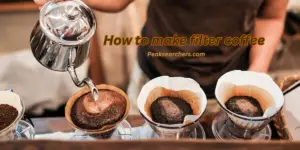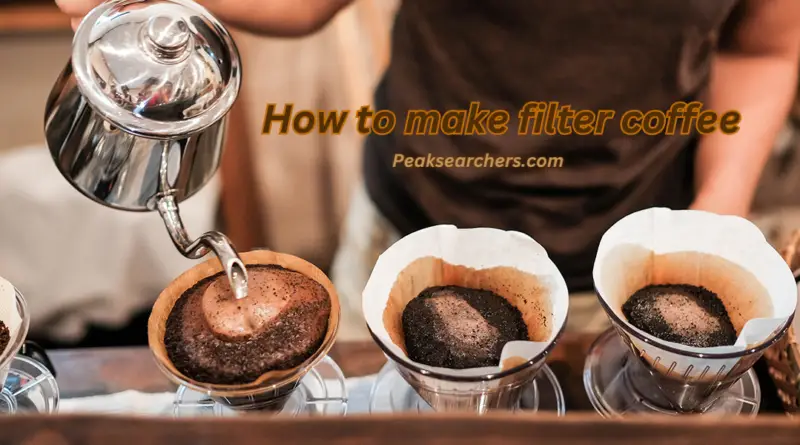How to make filter coffee? A Detailed Information
Coffee, often referred to as the elixir of life, has an uncanny ability to infuse energy and warmth into our daily routines. While there are countless ways to enjoy this beloved beverage, there’s something particularly satisfying about a well-brewed cup of filter coffee. Known for its rich, full-bodied flavor and aromatic qualities, filter coffee has a special place in the hearts of coffee aficionados around the world. In this article, we’ll guide you through the art of making the perfect cup of filter coffee right in the comfort of your own home.

Understanding Filter Coffee
Filter coffee, also known as drip coffee, is a method of brewing coffee that involves pouring hot water over coffee grounds contained in a filter, allowing the liquid to pass through the grounds and into a receptacle.
This process extracts the flavors, aromas, and essential oils from the coffee beans, resulting in a clean, well-balanced cup of coffee.
Unlike espresso, which is a concentrated and bold coffee variety, filter coffee is known for its mildness and approachability, making it a popular choice for daily consumption.
Ingredients and Equipment
Before we dive into the brewing process, let’s gather the essential ingredients and equipment you’ll need to make a delightful cup of filter coffee:
Ingredients:
- Fresh Coffee Beans: Choose high-quality coffee beans, preferably whole beans, and select your preferred roast level (light, medium, or dark).
- Fresh, Cold Water: The quality of the water is crucial. Use clean, filtered water, free from any unpleasant odors or flavors.
- Filter Paper: You’ll need coffee filter papers, which are specifically designed for this brewing method.
Equipment:
- Coffee Grinder: For the freshest coffee, invest in a burr grinder to grind your beans just before brewing.
- Coffee Maker: A drip coffee maker, Chemex, Hario V60, or any other pour-over device.
- Kettle: A gooseneck kettle is ideal for precise water control.
- Scale: A digital kitchen scale helps ensure accurate measurements.
- Timer: A timer, whether built into your scale or a separate device, helps maintain consistency.
Now that you have all your ingredients and equipment ready, let’s proceed with the step-by-step guide to making filter coffee.
Step 1: Measure the Coffee Beans
Start by measuring the coffee beans. A standard coffee-to-water ratio is 1:15, which means for every gram of coffee, you’ll use 15 grams of water. Adjust this ratio according to your taste preferences.
Step 2: Grind the Coffee Beans
Using your coffee grinder, grind the beans to a medium-coarse consistency. This grind size is ideal for filter coffee as it allows for proper extraction without over-extracting or under-extracting the coffee.
Step 3: Prepare the Filter
Place a coffee filter paper in your coffee maker or pour-over device. Rinse it with hot water to remove any paper residue and preheat your coffee maker. This step also ensures that your coffee flows smoothly through the filter.
Step 4: Add Coffee Grounds
Add the freshly ground coffee beans to the filter. Ensure that the coffee bed is level for even extraction.
Step 5: Heat the Water
Boil the fresh, cold water. Once it reaches the boiling point, let it cool slightly to around 200°F (93°C). Using water at this temperature prevents scalding the coffee grounds and extracting bitter flavors.
Step 6: Bloom the Coffee
Pour a small amount of hot water (about twice the weight of the coffee grounds) over the coffee in a circular motion. This step, called “blooming,” allows gases trapped in the coffee grounds to escape, resulting in better extraction. Let the coffee bloom for about 30 seconds.
Step 7: Begin Pouring
After the bloom, start pouring the remaining hot water over the coffee grounds in a slow, steady, and circular motion. Pour in stages, allowing the coffee to drain through the filter before adding more water. Maintain the coffee-to-water ratio as you pour.
Step 8: Control Brew Time
Use a timer to control the brew time. Typically, filter coffee takes around 3-4 minutes to brew. Adjust this time based on your taste preferences. Shorter brew times yield a milder cup, while longer brew times result in a stronger flavor.
Step 9: Serve and Enjoy
Once the coffee has finished brewing, remove the filter from your coffee maker or pour-over device. Pour the freshly brewed filter coffee into your favorite mug or cup.
Step 10: Customize to Taste
Now comes the fun part – customizing your cup of filter coffee to your liking. You can add sugar, milk, cream, or enjoy it black. Experiment with different flavorings, spices, or syrups for a unique twist.
Tips for the Perfect Filter Coffee
- Use Fresh Coffee Beans: Freshness is key to a flavorful cup of coffee. Buy whole beans and grind them just before brewing.
- Water Quality Matters: Use clean, filtered water to avoid any undesirable flavors in your coffee.
- Experiment with Grind Size: Adjust the grind size to control the extraction and flavor profile of your coffee.
- Consistent Pouring: Maintain a steady, consistent pour during brewing to ensure even extraction.
- Invest in Quality Equipment: Quality grinders, coffee makers, and kettles can make a significant difference in the final cup.
- Keep it Clean: Regularly clean your coffee maker and equipment to prevent the buildup of coffee residues.
Also Read: How to make coffee on the stove? A Comprehensive Guide
FAQ’s
How much coffee do you put in a filter coffee?
The amount of coffee you should use in a filter coffee maker can vary depending on your personal taste and the size of the coffee maker. However, a general guideline is to use approximately 1 to 2 tablespoons of ground coffee for every 6 ounces (about 177 milliliters) of water. This is a common ratio used to make a standard cup of coffee.
So, if you’re making a 12-cup pot of coffee in a drip coffee maker, you would typically use about 12 to 24 tablespoons of coffee grounds. You can adjust the amount of coffee to make it stronger or milder according to your preference. Keep in mind that factors like the grind size of the coffee, the type of coffee beans, and personal taste can all influence the ideal coffee-to-water ratio, so feel free to experiment to find what suits you best.
What is the difference between filter coffee and regular coffee?
The terms “filter coffee” and “regular coffee” are often used interchangeably, but they can sometimes have slightly different connotations depending on the context. Here’s a breakdown of the differences:
- Brewing Method:
- Filter Coffee: “Filter coffee” usually refers to coffee that is brewed using a drip coffee maker or a pour-over method. In this process, hot water is poured over ground coffee beans, and the brewed coffee drips through a paper or metal filter into a pot or carafe.
- Regular Coffee: “Regular coffee” is a more general term that can encompass a variety of brewing methods, including filter coffee, but it can also refer to coffee brewed through other methods like French press, AeroPress, espresso, or Turkish coffee.
- Ground Coffee Size:
- Filter Coffee: Typically, filter coffee is made using medium-coarse to medium-ground coffee beans. This grind size is well-suited for the drip brewing process, where water flows through the grounds.
- Regular Coffee: The grind size for regular coffee can vary widely depending on the brewing method. For example, espresso requires a fine grind, while French press coffee uses a coarser grind.
- Flavor and Strength:
- Filter Coffee: Filter coffee is known for its clean and mild flavor profile. It tends to have a smoother and less concentrated taste than other brewing methods.
- Regular Coffee: “Regular coffee” can encompass a wide range of flavors and strengths, depending on factors like the brewing method, coffee bean type, grind size, and brewing time. It can be milder or stronger, depending on personal preference.
What is the ratio of coffee to water?
The ratio of coffee to water can vary depending on your personal taste and the brewing method you’re using. However, a commonly recommended starting point for a standard cup of coffee is about 1 to 2 tablespoons of ground coffee for every 6 ounces (about 177 milliliters) of water. This is a general guideline, and you can adjust the ratio to suit your taste preferences. Here are a few examples of coffee-to-water ratios for different brewing methods:
- Drip Coffee Maker (Filter Coffee):
- Use 1 to 2 tablespoons of coffee grounds per 6 ounces of water.
- Pour-Over Coffee:
- Use 1 to 2 tablespoons of coffee grounds per 6 ounces of water.
- Adjust the grind size and pouring technique to control the strength and flavor.
- French Press:
- Use a coarser grind and aim for a ratio of 1 to 2 tablespoons of coffee grounds per 6 ounces of water.
- Steep the coffee for about 4 minutes before pressing the plunger.
- Espresso:
- Espresso uses a much finer grind and a different brewing method. A common ratio is about 1 to 2 ounces (30 to 60 milliliters) of espresso for a single shot, which requires around 7 to 14 grams of coffee grounds.
- AeroPress:
- The AeroPress is versatile, and the ratio can vary. A typical starting point is 1 to 2 tablespoons of coffee per 6 ounces of water.
Remember that these are general guidelines, and the ideal coffee-to-water ratio can vary based on factors like the type of coffee beans, roast level, and personal taste preferences. It’s a good idea to experiment and adjust the ratio to achieve the coffee strength and flavor you enjoy most.
Also Read: How to Clean Your Black and Decker Coffee Maker: A Step-by-Step Guide
Conclusion
Making the perfect cup of filter coffee is an art that anyone can master with a bit of practice and attention to detail. By following the steps outlined in this guide and experimenting with different beans and brewing techniques, you can discover the nuanced flavors and aromas of filter coffee. So, brew a fresh batch, savor the aroma, and enjoy the soothing, flavorful experience of filter coffee in the comfort of your own home.


